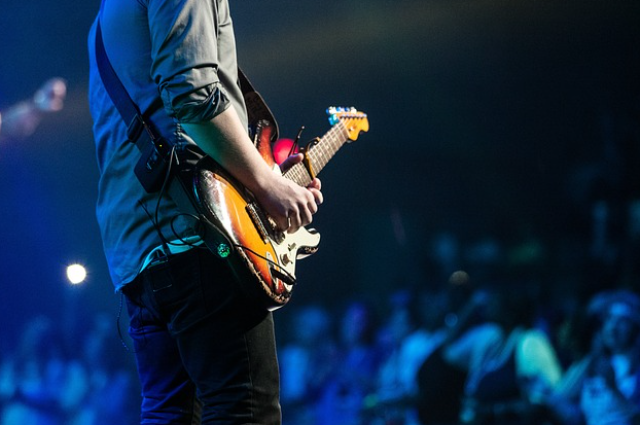
Music is one of those forms of arts, which is accessible to even the most simple-minded beings, plants being no exception in this case. India, has always been home to vibrant music and a variety of artists, with art forms that traverse generations.
“Music is the literature of the heart; it commences where speech ends.” – Alphonse de Lamartine.
India has a rich cultural tapestry with a long history of music and music festivals. From the ancient Vedic hymns to the contemporary fusion of classical and modern sounds, music festivals in India have come a long way and have a promising future, which only plans to enthrall more music aficionados. Music festivals are much more than just basic tunes that cater to the average audience for popularity and income, rather, they are truly a fiesta for the festival faithful and the music enthusiasts. India has had a long history of hosting such festivals, to mention one, the Khajuraho dance festival, which has been a part of India’s cultural heritage for centuries. The culture of frowning upon Western music and genres that weren’t synonymous with the classical styles of music had stubborn roots in Indian society, but today, even the children in India are aware of music festivals such as Sunburn, which feature EDM. Such a major shift in the Indian music world was a consequent result of the 2000s, when the people gave recognition to not just classical and Bollywood tunes, but also gave a chance to international artists and new genres as well. With globalisation on the rise, this shift kept intensifying, giving India some of its most remarkable musical events, such as the Sunburn (2007- present), Magnetic Fields (2013 – present), NH7 Weekender (2010 – present), Ziro Music Festival ( 2012 – present), and more.
Such events serve as great platforms for artistic expression and for introducing people to new talents in the field, captivating viewers from all over India as well as abroad. Additionally, these festivals help uplift the regional economy. Most of these showcase the talent of independent artists, rather than the mainstream industry. So, having a full-on win-win appeal, these festivals have now become a major attraction for audiophiles and tourists everywhere. However, these festivals have come up with a reputation for drug abuse. A concerning matter indeed for the youth of India. Often, cocaine and substances that increase euphoria, like ecstasy or MDMA, are used by festival goers. Sunburn has often been at the eye of these accusations in promoting ‘drug culture’. A study published in the ‘International Journal of Drug Policy’ in 2019 revealed that one-third of the people who go to electronic dance music parties had experienced a drug-related adverse effect in the past year.
It is extremely easy for first-time goers to give in to peer pressure and subject themselves to such drugs, which can easily land them in a hospital in case of a small overdose. Despite the security measures taken, the will can always find substances to abuse through money and covert networks. It is paramount that the authorities provide on-site awareness, highlighting the adverse effects of drug abuse and providing them with other forms of recreation that aren’t harmful. Immediate emergency assistance is a must. Pre-event briefings with the local police and vendors can help control the situation better. Rather than only implementing stricter laws, the authorities must focus on educating, protecting, and providing people a safe space to be their best sober selves.
The 2000s witnessed the growing popularity of Western music and Electronic Dance Music (EDM), leading to a diverse landscape of festivals showcasing both traditional and contemporary genres. India has one of the largest youth populations, which only made it easier for EDM to rule their hearts and make a home in India. EDM in India often fuses with Bollywood, bhangra, folk instruments, and even classical music. India has become a key market for EDM touring strategies. The concert culture in India has only grown ever since the rise of these festivals. From house concerts and open mics to grand spectacles with performers and viewers from across the globe. With more and more international artists touring and performing, the artistic perspective of the Indian audience has only broadened. These fests include indie rock, folk music, and regional music as well, which rightly reflect the true rich cultural spirit of India. This major shift in the musical landscape of India can be greatly attributed to the meteoric rise of social media. With Facebook and other social media platforms blowing up, they subsequently fueled the growth of music festivals and concerts. Sunburn and VH1 Supersonic attracted international attendees, boosting tourism and firming the roots of our festive spirit, which encompasses art forms as well. Featuring world-class artists like DJ Snake, David Guetta, Hardwell, and more, they set the bar every year for new performers. Music festivals in India not just cater to the western taste, with EDM and more, but they have come to play an important part in preserving and remixing folk music as well. This musical shift in the 2000s can also be attributed to the surge of easily affordable technology in the market. The 2000s also saw the rise of many Indian bands that were adored for their unique blend of rock, folk, and classical music. Indian Ocean, Indus Creed, Pentagram, and Motherjane were some of those bands that often performed at musical festivals all over India.
The youth of today is the generation that will go down in history as the generation of romantics, who made such captivating blends and established a thrilling music culture among the common people that will last for centuries. The early 2000s will always be remembered fondly by us Indians, leaving a glowing orb in its wake that will continue to warm our hearts for years to come. While the iconic fashion or the cassettes of the 2000s might have been lost with time, the beats still linger and rivet hearts like none other.
